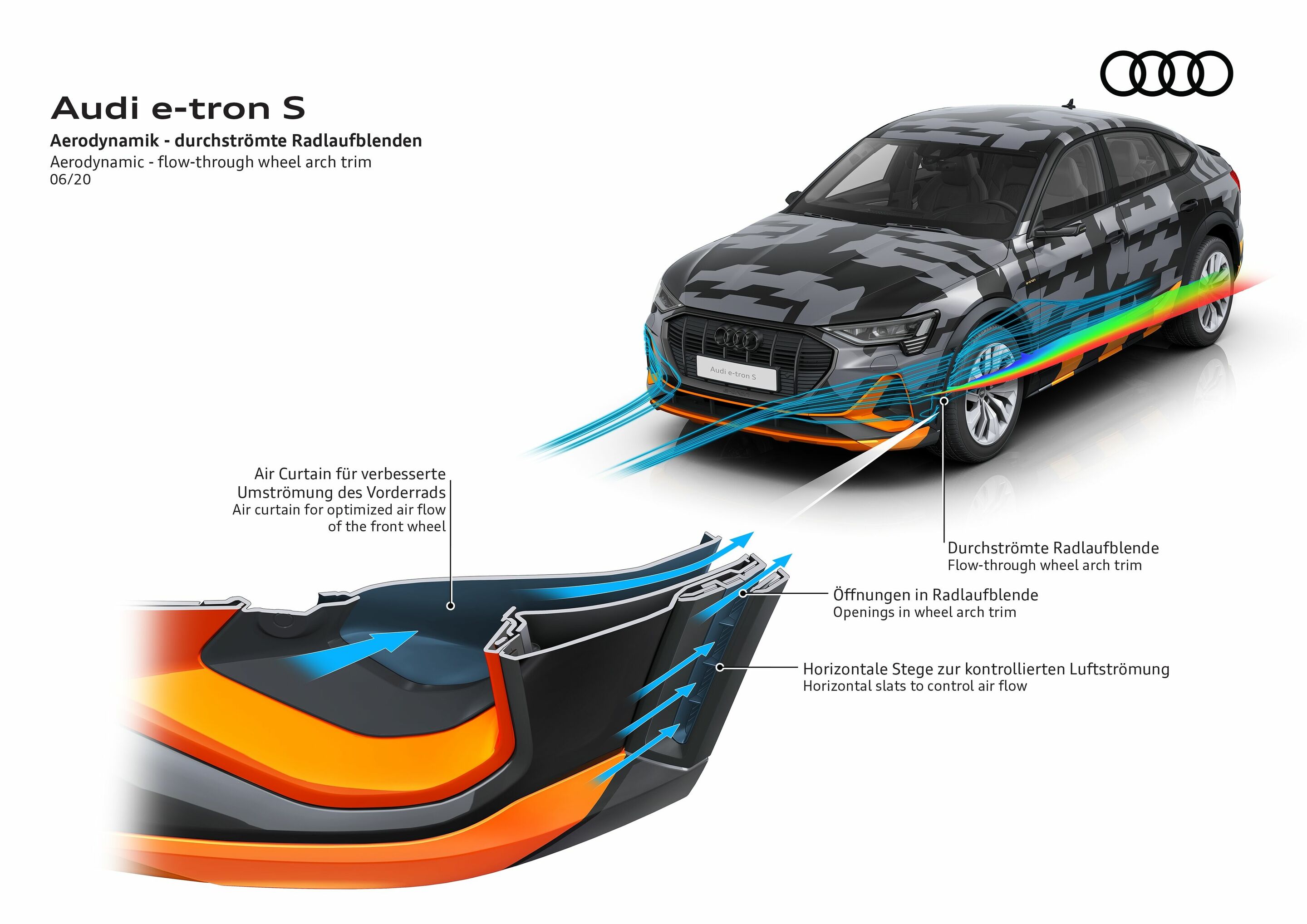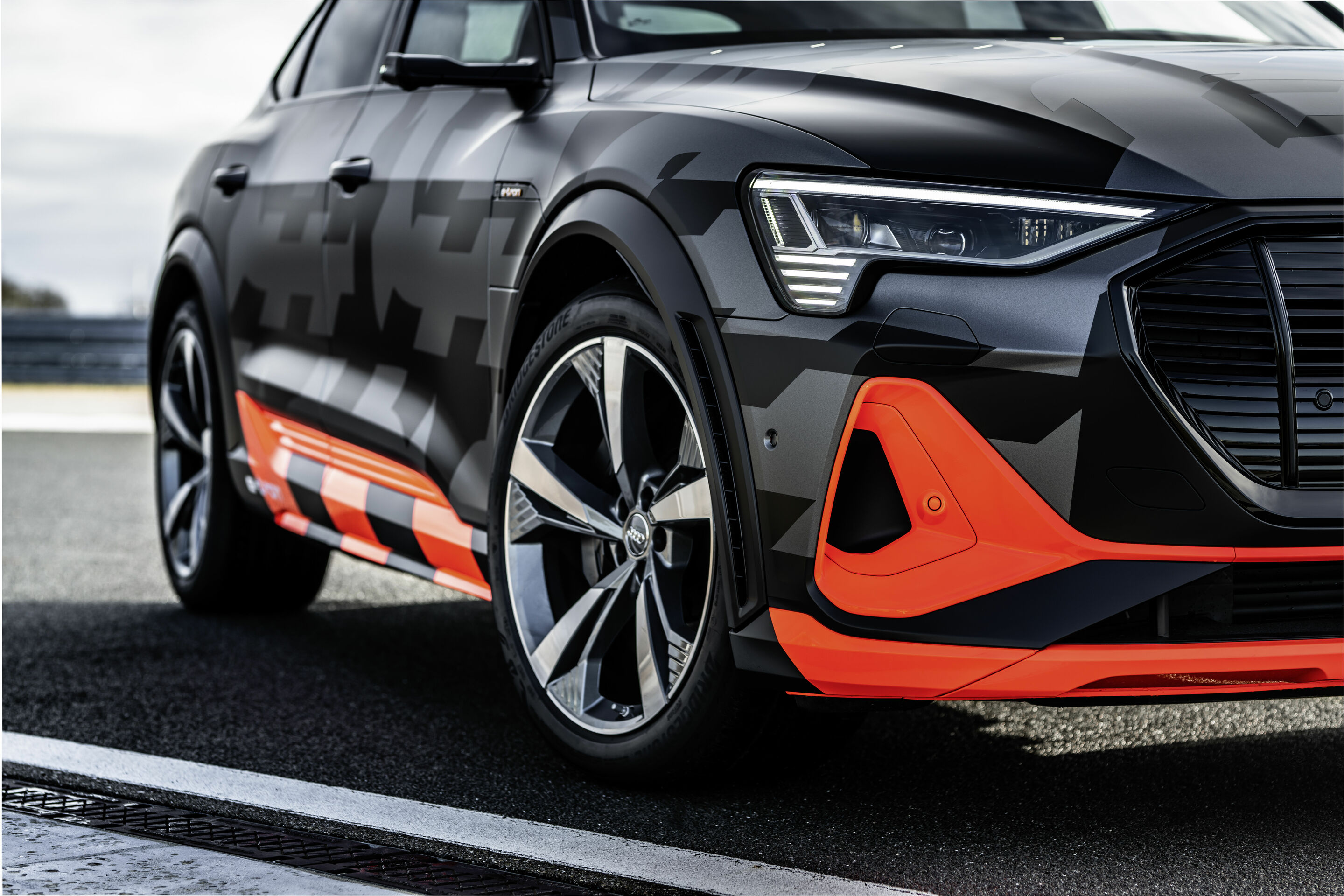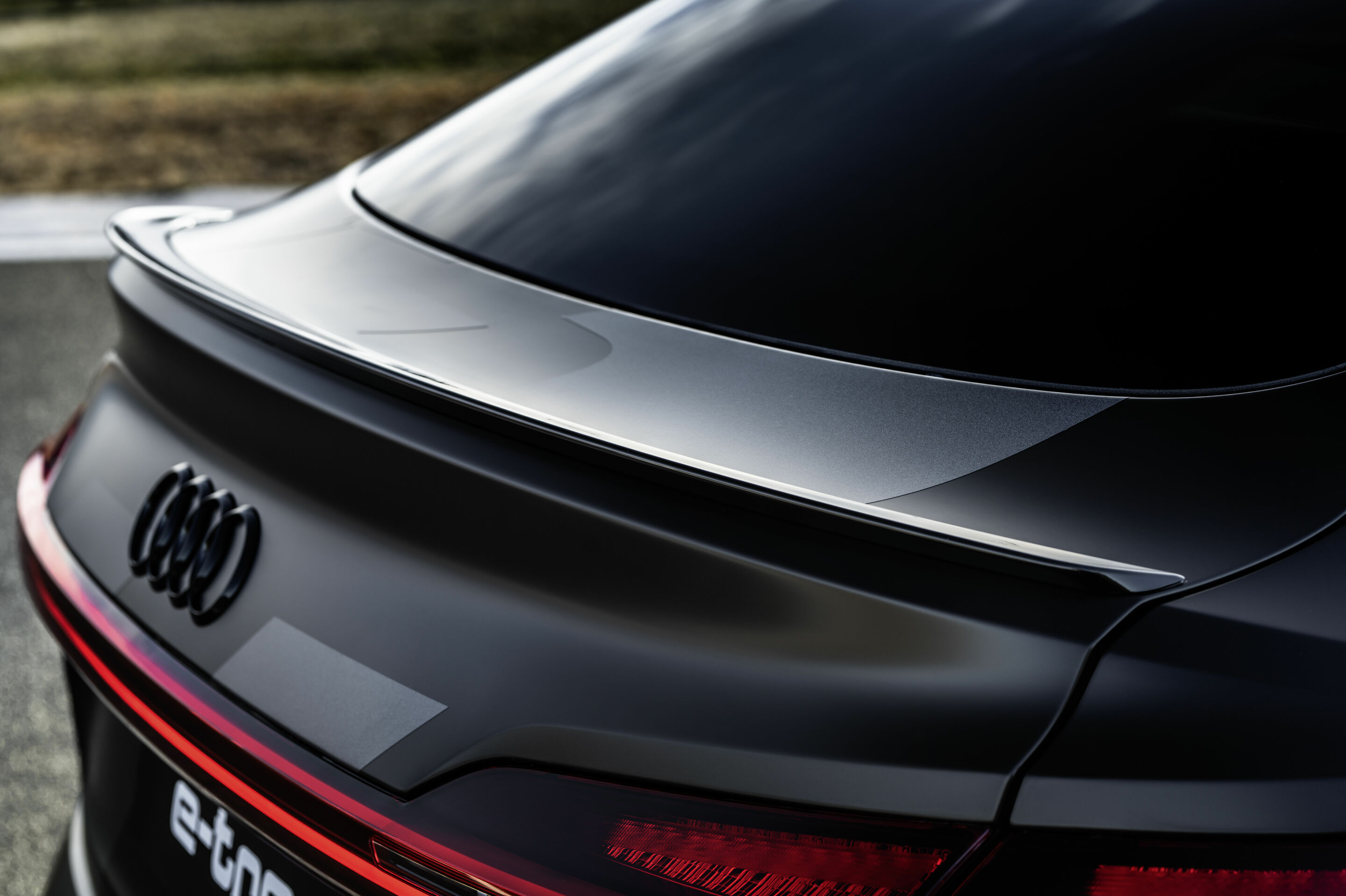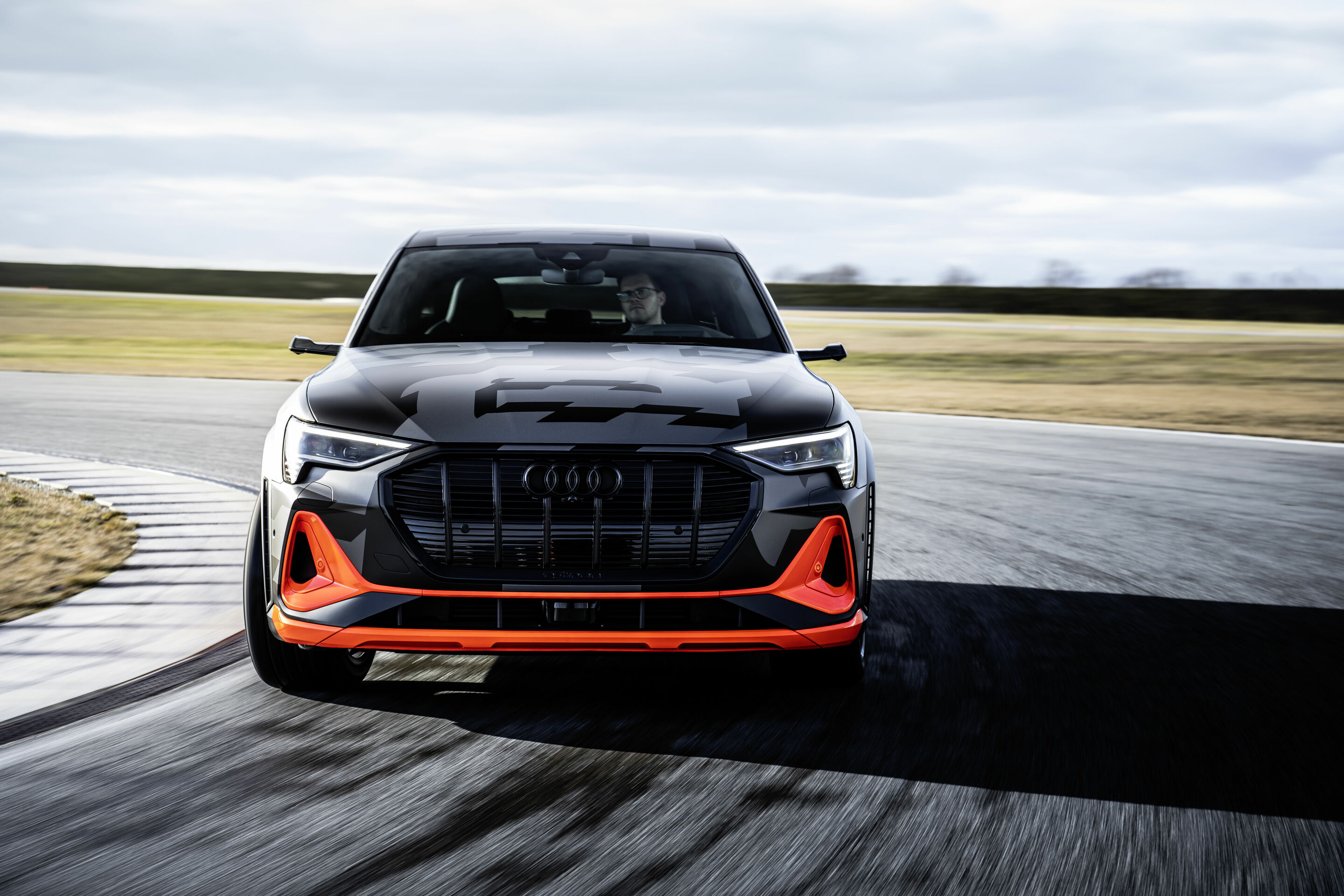Innovative aerodynamics concept of the
Audi e-tron S models
- Top aerodynamic drag figure of 0.26 for the e-tron S Sportback prototype
- Wheel arch trims with air flow-through as new Audi patent, plus fully enclosed floor pan and controllable cool-air inlet
- Virtual exterior mirrors with OLED displays in the interior
Aerodynamics is a key factor in range particularly with all-electric automobiles. Thanks to smart technology innovations, Audi’s sporty SUV coupé achieves a remarkably low drag coefficient figure of 0.26. The sophisticated aerodynamics concept features many innovative detailed solutions.
The electrically powered S models reveal their power through sporty details on the exterior – the wheel arch trims, for instance, are 23 millimeters (0.9 in) wider on both sides than on the basic version. The striking design takes it cue from aerodynamics based firmly on new technologies. The SUV coupé’s quickly downward-sloping roof line further improves the drag coefficient compared with the sister model. And in particular a spoiler edge on its trunk lid improves the airflow direction at the rear.
Optimized airflow through the front wheels: air curtains and airflow through wheel arch trims
The controlled airflow at the front wheels is fundamental to the aerodynamics concept. The side air inlets in the front – the air curtains – route the air over a channel in the wheel houses to optimize the airflow to the wheels and the vehicle flank. The airflow through the wheel arch trims serves the same purpose: Narrow horizontal bars in the recesses formed by the widened trims in the front channel the airstream to surround and encapsulate disruptive swirl in the wheel houses. The upshot is “cleaner” airflow along the vehicle flank with reduced flow losses. The design of the 20-inch wheels as well as the tread and the pattern on the sidewalls of the tires have also been optimized accordingly.
The airflow through the wheel arch trims helps Audi resolve the conflict of objectives between outstanding aerodynamics and sporty looks. For the first time, the brand with the Four Rings is bringing this innovative, patented solution to high-volume automobile production. The future Audi e-tron S Sportback will achieve a drag coefficient figure of 0.26 – the Audi e-tron S 0.28.
Virtual exterior mirrors with OLED displays in the interior
Compared with standard mirrors, the sleek virtual exterior mirrors further reduce aerodynamic drag. They help improve aerodynamics by around the same amount as the airflow through the wheel arches and increase range by around three kilometers (1.9 mi)in the WLTP cycle. The virtual exterior mirrors were another world first from the Four Rings that already went into volume production in the Audi e-tron quattro (combined electric power consumption in kWh/100 km (62.1 mi)*: 26.6 – 22.4 (WLTP); 24.3 – 21.0 (NEDC); combined CO2 emissions in g/km: 0). Each of their flat supports integrates a small camera at the ends. The captured images appear in the interior on high-contrast OLED displays located in the transition between door and instrument panel. Whether driving on the highway, turning or parking, the field of view adjusts to each driving situation.
The sophisticated aerodynamics concept of the future e-tron S models continues under the vehicle floor. Here underfloor paneling with spoiler elements cleanly routes the air around the vehicle. The underfloor together with the aluminum cover plate for the high-voltage battery is enclosed. The bolting points come with bowl-shaped indentations, similar to the dimples on a golf ball. They make the air flow much better than a totally flat surface. The standard adaptive air suspension – the air suspension with controlled damping – further helps improve the aerodynamic drag: At high speeds, it lowers the body up to 26 millimeters (1.0 in) below the standard height in two stages.
Part of thermal management: the controllable cool-air inlet
The controllable cool-air inlet is an important component, which also acts as the thermal management control center. It comprises a frame behind the Singleframe with two electrically operated louvers. At speeds between 48 and 160 km/h (29.8 and 99.4 mph) these are usually closed so that the air flows over the hood with virtually no swirl. If the air conditioning system or the drive components require more cooling air, the louvers open gradually. If the hydraulic wheel brakes are subjected to extremely high loads in exceptional circumstances, the controllable cool-air inlet releases two channels that route air to the front wheel arches. If necessary, the cooling fan is turned on.
Up to 973 Nm (717.6 lb-ft) of torque: innovative drive concept with three electric motors
The future e-tron S models will stand out thanks to their extraordinary performance in addition to their outstanding aerodynamic characteristics. The two new flagship models in the Audi e-tron model line use three electric motors, two of which work at the rear axle. Together they produce 370 kW boost output and up to 973 Nm (717.6 lb-ft) of torque. The S models each sprint from a standstill to 100 km/h (62.1 mph) in 4.5 seconds. Their intelligent drive control raises vehicle safety, and dynamic handling in particular, to a new level. In addition to the electric all-wheel drive, there is the electric torque vectoring with active and fully variable torque distribution on the rear axle.
Fuel consumption of the models named above:
(Information on fuel/electric power consumption and CO2 emission figures given in ranges depend on the equipment selected for the vehicle)
Audi e-tron 55 quattro
Combined electric power consumption in kWh/100 km (62.1 mi): 26.4 - 22.4 (WLTP); 23.1 - 21.0 (NEDC)
Combined CO2 emissions in g/km: 0
Audi e-tron 50 quattro
Combined electric power consumption in kWh/100 km (62.1 mi): 26.6 - 22.4 (WLTP); 24.3 - 21.9 (NEDC)
Combined CO2 emissions in g/km: 0




